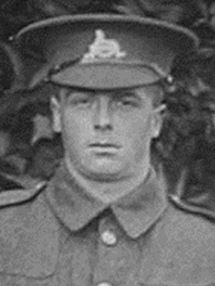Pte
Hubert Cox
Informations sur naissance
|
Date de naissance: 04/06/1893 |
|
Lieu de naissance: Bigby, Lincolnshire, Angleterre, Royaume-Uni |
Informations générales
|
Profession: Menuisier |
Informations service militaire
|
Pays: Angleterre, Royaume-Uni |
|
Force armée: British Expeditionary Force |
|
Rang: Private |
|
Numéro de service: 1391 |
|
Incorporation date: 10/03/1915 |
|
Incorporation nom de lieu: Grimsby, Lincolnshire, Angleterre, Royaume-Uni |
|
Unités: — Lincolnshire Regiment, 1st Bn. (Dernière unité connue) |
Informations sur décès
|
Date de décès: 04/10/1917 |
|
Lieu de décès: Reutel, Beselare, Belgique |
|
Cause du décès: Killed in action (K.I.A.) |
|
Âge: 24 |
Mémorial
|
Tyne Cot Memorial Panneau: 36 |
Distinctions et médailles 2
|
British War Medal Médaille |
|
Victory Medal Médaille |
Points d'intérêt 3
| #1 | Lieu de naissance | ||
| #2 | Lieu d'enrôlement | ||
| #3 | Lieu du décès (approximatif) |
Mon histoire
Private Hubert Cox served in the 1st Bn. Lincolnshire Regiment, part of the 62nd Brigade, of the21st Division. On the 4th of October 1917, the Division participated in the Battle of Broodseinde, a stage of the Third Battle of Ypres.
The 21st Division’s jumping off line was located near the eastern border of Polygon Wood. The attack on the hamlet of Reutel was planned as followed : the first objective was to be taken by the The Queens (Royal West Surrey Regiment) 3rd/4th Battalion. Once the objective was captured, the 12th/13th Northumberland Fusiliers (on the right) and the 10th Bn. Yorkshire Regiment (on the left) were to advance to the second objective. The 1st Bn. Lincolnshire Regiment would be in support.
But things didn’t go as planned. While the 10th Bn. Yorkshire Regiment was on its way to the assembly point, it was caught in two heavy German barrages ; one in Glencorse Wood and one at Black Watch Corner. The Battalion became disorganized, suffered heavy casualties and did not succeed in arriving on time at the assembly point. Therefore the 1st Lincolnshire took the place of the 10th Yorkshire in the line.
The attack started at 6 a.m. with an opening barrage and the leading battalions advanced behind the creeping barrage. The attacking Battalions had to overcome several obstacles ; the first was the Polygonebeek. The banks of this small stream had been utterly destroyed by the constant shelling. Without proper irrigation the entire valley was transformed in a marsh, making any quick progress next to impossible. On top of the difficult terrain, the leading battalions were surprised by some well-hidden German concrete emplacements, on the east bank of the Polygonebeek.
Nevertheless the 3rd/4th Queens succeeded in capturing these concrete shelters and at 7.45 a.m. they consolidated the first Objective. The 1st Lincolnshire and the 12th/13th Northumberland Fusiliers continued the attack on the Second Objective. Soon after the 1st Lincolnshire took over the advance they came under fire from Judge Copse. The heavy German machine gun- and rifle fire caused considerable casualties. Yet the 1st Lincolnshire reached the second and final objective at 11.30 a.m.
Private HubertCox fell during the attack on Reutel. His remains were never found or never identified. Private Hubert Cox is remembered on Tyne Cot Memorial.
The 21st Division’s jumping off line was located near the eastern border of Polygon Wood. The attack on the hamlet of Reutel was planned as followed : the first objective was to be taken by the The Queens (Royal West Surrey Regiment) 3rd/4th Battalion. Once the objective was captured, the 12th/13th Northumberland Fusiliers (on the right) and the 10th Bn. Yorkshire Regiment (on the left) were to advance to the second objective. The 1st Bn. Lincolnshire Regiment would be in support.
But things didn’t go as planned. While the 10th Bn. Yorkshire Regiment was on its way to the assembly point, it was caught in two heavy German barrages ; one in Glencorse Wood and one at Black Watch Corner. The Battalion became disorganized, suffered heavy casualties and did not succeed in arriving on time at the assembly point. Therefore the 1st Lincolnshire took the place of the 10th Yorkshire in the line.
The attack started at 6 a.m. with an opening barrage and the leading battalions advanced behind the creeping barrage. The attacking Battalions had to overcome several obstacles ; the first was the Polygonebeek. The banks of this small stream had been utterly destroyed by the constant shelling. Without proper irrigation the entire valley was transformed in a marsh, making any quick progress next to impossible. On top of the difficult terrain, the leading battalions were surprised by some well-hidden German concrete emplacements, on the east bank of the Polygonebeek.
Nevertheless the 3rd/4th Queens succeeded in capturing these concrete shelters and at 7.45 a.m. they consolidated the first Objective. The 1st Lincolnshire and the 12th/13th Northumberland Fusiliers continued the attack on the Second Objective. Soon after the 1st Lincolnshire took over the advance they came under fire from Judge Copse. The heavy German machine gun- and rifle fire caused considerable casualties. Yet the 1st Lincolnshire reached the second and final objective at 11.30 a.m.
Private HubertCox fell during the attack on Reutel. His remains were never found or never identified. Private Hubert Cox is remembered on Tyne Cot Memorial.
Sources 1
|
McCarthy C., The Third Ypres Passchendaele. The Day-by-Day Account, (London, Arms & Armour Press, 1995), pg. 98. Sources utilisées |
Complément d’informations 3
|
Commonwealth War Graves Commission Database https://www.cwgc.org/find-records/find-war-dead/casualty-details/841607 |
|
Namenlijst (In Flanders Fields Museum) https://namenlijst.org/publicsearch/#/person/_id=494a6890-b0a4-4aab-849d-575ca39e28b4 |
|
Lives of the First World War (Imperial War Museum) https://livesofthefirstworldwar.iwm.org.uk/lifestory/990909 |
